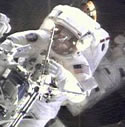
Image credit: NASA
During a seven and a half hour spacewalk today, astronauts James Newman and Michael Massimino installed the Advanced Camera for Surveys onto the Hubble Space Telescope – a camera system ten times more powerful than what Hubble had previously. This is the fourth of five spacewalks carried out by the Columbia crew, who are due to return back to Earth on March 12th. The next spacewalk is due for Friday.
Following today?s successful installation of the new Advanced Camera for Surveys (ACS) on the Hubble Space Telescope, scientists will be able to see farther into our universe and with greater clarity and speed than ever before.
Columbia?s spacewalkers, Jim Newman and Mike Massimino, began the first science instrument upgrade of this servicing mission at 3 a.m. central time. The duo, with Newman on the shuttle?s robotic arm, began by removing the last of Hubble?s original science instruments, the Faint Object Camera to make room for the ACS. Newman and Massimino first opened Hubble?s aft shroud doors, removing the Faint Object Camera and temporarily stowing it at the edge of Columbia?s payload bay. After installing the ACS in the Hubble, Newman and Massimino stowed the old camera in the payload bay for its return to Earth.
Then Massimino, on the shuttle?s robotic arm, installed the Electronic Support Module in the aft shroud, with Newman?s assistance. That module will support a new experimental cooling system to be installed during tomorrow?s fifth and final scheduled spacewalk of the mission. That cooling system is designed to bring the telescope’s Near-Infrared Camera and Multi-Object Spectrometer (NICMOS) back to life.
Finally, Newman and Massimino completed some remaining cleanup tasks from yesterday?s Power Control Unit installation.
During the first half of the spacewalk, mission specialist Nancy Currie operated the shuttle?s robotic arm, providing transportation to and from the various worksites on both the Hubble and in Columbia?s payload bay ? Commander Scott Altman then took over operation of the arm to maneuver Massimino through his tasks.
Fellow spacewalkers John Grunsfeld and Rick Linnehan worked from inside the shuttle to choreograph the spacewalk, as Altman and Pilot Duane Carey continued to provide photo and video documentation of the work.
Initial functional tests on the ACS and the electronics module conducted by the Space Telescope Operations Control Center in Greenbelt, Md. were both good. Functional tests of the telescope’s scientific instruments will not be completed, however, until after the telescope is released from Columbia and its aperture door is opened.
The crew is to begin its sleep period at 2:52 p.m. CST. The next STS-109 mission status report will be issued Thursday evening following crew wake-up, or as events warrant.
Original Source: NASA News Release
